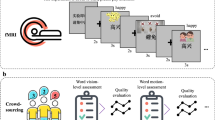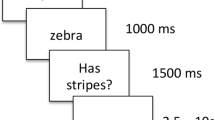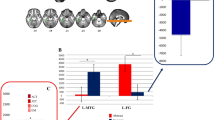Abstract
We investigate whether semantic information related to object categories can be obtained from human fMRI BOLD responses with Formal Concept Analysis (FCA). While the BOLD response provides only an indirect measure of neural activity on a relatively coarse spatio-temporal scale, it has the advantage that it can be recorded from humans, who can be questioned about their perceptions during the experiment, thereby obviating the need of interpreting animal behavioral responses. Furthermore, the BOLD signal can be recorded from the whole brain simultaneously. In our experiment, a single human subject was scanned while viewing 72 gray-scale pictures of animate and inanimate objects in a target detection task. These pictures comprise the formal objects for FCA. We computed formal attributes by learning a hierarchical Bayesian classifier, which maps BOLD responses onto binary features, and these features onto object labels. The connectivity matrix between the binary features and the object labels can then serve as the formal context. In line with previous reports, FCA revealed a clear dissociation between animate and inanimate objects with the inanimate category also including plants. Furthermore, we found that the inanimate category was subdivided between plants and non-plants when we increased the number of attributes extracted from the BOLD response. FCA also allows for the display of organizational differences between high-level and low-level visual processing areas. We show that subjective familiarity and similarity ratings are strongly correlated with the attribute structure computed from the BOLD signal.
Access this chapter
Tax calculation will be finalised at checkout
Purchases are for personal use only
Preview
Unable to display preview. Download preview PDF.
Similar content being viewed by others
References
Bell, A.H., Hadj-Bouziane, F., Frihauf, J.B., Tootell, R.B.H., Ungerleider, L.G.: Object representations in the temporal cortex of monkeys and humans as revealed by functional magnetic resonance imaging. Journal of Neurophysiology 101(2), 688–700 (2009), http://jn.physiology.org/content/101/2/688.abstract
Bell, A.H., Malecek, N.J., Morin, E.L., Hadj-Bouziane, F., Tootell, R.B.H., Ungerleider, L.G.: Relationship between functional magnetic resonance imaging-identified regions and neuronal category selectivity. The Journal of Neuroscience 31(34), 12229–12240 (2011), http://www.jneurosci.org/content/31/34/12229.abstract
Bishop, C.M.: Pattern Recognition and Machine Learning. Springer (2006)
Brett, M., Anton, J., Valabregue, R., Poline, J.: Region of interest analysis using an SPM toolbox. Neuroimage 16(2) (2002); 8th International Conference on Functional Mapping of the Human Brain
Eger, E., Ashburner, J., Haynes, J.D., Dolan, R.J., Rees, G.: fMRI activity patterns in human LOC carry information about object exemplars within category. J. Cogn. Neurosci. 20(2), 356–370 (2008)
Endres, D., Földiák, P., Priss, U.: An application of formal concept analysis to semantic neural decoding. Annals of Mathematics and Artificial Intelligence 57(3-4), 233–248 (2010), doi:10.1007/s10472-010-9196-8
Evans, A.C., Marrett, S., Neelin, P., Collins, L., Worsley, K., Dai, W., Milot, S., Meyer, E., Bub, D.: Anatomical mapping of functional activation in stereotactic coordinate space. Neuroimage 1(1), 43–53 (1992)
Földiák, P.: Sparse coding in the primate cortex. In: Arbib, M.A. (ed.) The Handbook of Brain Theory and Neural Networks, 2nd edn. MIT Press, Cambridge (2002)
Friston, K.J., Holmes, A.P., Price, C.J., Buchel, C., Worsley, K.J.: Multisubject fMRI studies and conjunction analyses. Neuroimage 10(4), 385–396 (1999)
Friston, K., Holmes, A., Worsley, K., Poline, J., Frith, C., Frackowiak, R.: Statistical parametric mapping: a general linear approach. Hum. Brain Mapping 2, 189–210 (1995)
Ganter, B., Wille, R.: Formal Concept Analysis: Mathematical foundations. Springer (1999)
Harpur, G.F., Prager, R.W.: Experiments with low-entropy neural networks. In: Baddeley, R., Hancock, P., Földiák, P. (eds.) Information Theory and the Brain, ch. 5, pp. 84–100. Cambridge University Press, New York (2000)
Haxby, J., Gobbini, M., Furey, M., Ishai, A., Schouten, J., Pietrini, P.: Distributed and overlapping representations of faces and objects in ventral temporal cortex. Science 5539(293), 2425–2430 (2001)
Josephs, O., Turner, R., Friston, K.J.: Event-related fMRI. Human Brain Mapping 5, 243–248 (1997)
Kandel, E.R., Schwartz, J.H., Jessell, T.M. (eds.): Principles of Neural Science, ch. 25-29. McGraw-Hill Education (2000)
Kiani, R., Esteky, H., Mirpour, K., Tanaka, K.: Object category structure in response patterns of neuronal population in monkey inferior temporal cortex. Journal of Neurophysiology 97(6), 4296–4309 (2007)
Knebel, J.F., Toepel, U., Hudry, J., le Coutre, J., Murray, M.M.: Generating controlled image sets in cognitive neuroscience research. Brain Topogr. 20(4), 284–289 (2008)
Kriegeskorte, N., Mur, M., Ruff, D.A., Kiani, R., Bodurka, J., Esteky, H., Tanaka, K., Bandettini, P.A.: Matching categorical object representations in inferior temporal cortex of man and monkey. Neuron 60(6), 1126–1141 (2008)
Lengnink, K.: Formalisierungen von Ähnlichkeit aus Sicht der Formalen Begriffsanalyse. Ph.D. thesis, Technische Hochschule Darmstadt, Fachbereich Mathematik (1996)
Lin, C.J.: Projected gradient methods for non-negative matrix factorization. Neural Computation 19, 2756–2779 (2007)
Mishkin, M., Ungerleider, L.G., Macko, K.A.: Object vision and spatial vision: two cortical pathways. Trends in Neurosciences 6, 414–417 (1983), http://www.sciencedirect.com/science/article/pii/016622368390190X
Olshausen, B.A., Field, D.J.: Emergence of simple-cell receptive field properties by learning a sparse code for natural images. Nature 381(6583), 607–609 (1996)
Op de Beeck, H.P., Haushofer, J., Kanwisher, N.G.: Interpreting fMRI data: maps, modules and dimensions. Nat. Rev. Neurosci. 9(2), 123–135 (2008)
Press, W.H., Teukolsky, S.A., Vetterling, W.T., Flannery, B.P.: Numerical recipes in C++: the art of scientific computing, 3rd edn. Cambridge University Press, New York (2007)
Tversky, A.: Features of similarity. Psychological Review 84(4), 327–352 (1977)
Tzourio-Mazoyer, N., Landeau, B., Papathanassiou, D., Crivello, F., Etard, O., Delcroix, N., Mazoyer, B., Joliot, M.: Automated anatomical labeling of activations in SPM using a macroscopic anatomical parcellation of the mni MRI single-subject brain. Neuroimage 15(1), 273–289 (2002)
Uludag, K., Dubowitz, D., Buxton, R.: Basic principals of functional MRI, pp. 249–287. Elsevier (2005)
Walther, D.B., Caddigan, E., Fei-Fei, L., Beck, D.M.: Natural scene categories revealed in distributed patterns of activity in the human brain. J. Neurosci. 29(34), 10573–10581 (2009)
Wille, R.: Restructuring lattice theory: an approach based on hierarchies of concepts. In: Rival, I. (ed.) Ordered Sets, pp. 445–470. Reidel, Dordrecht (1982)
Author information
Authors and Affiliations
Editor information
Editors and Affiliations
Rights and permissions
Copyright information
© 2012 Springer-Verlag Berlin Heidelberg
About this paper
Cite this paper
Endres, D., Adam, R., Giese, M.A., Noppeney, U. (2012). Understanding the Semantic Structure of Human fMRI Brain Recordings with Formal Concept Analysis. In: Domenach, F., Ignatov, D.I., Poelmans, J. (eds) Formal Concept Analysis. ICFCA 2012. Lecture Notes in Computer Science(), vol 7278. Springer, Berlin, Heidelberg. https://doi.org/10.1007/978-3-642-29892-9_13
Download citation
DOI: https://doi.org/10.1007/978-3-642-29892-9_13
Publisher Name: Springer, Berlin, Heidelberg
Print ISBN: 978-3-642-29891-2
Online ISBN: 978-3-642-29892-9
eBook Packages: Computer ScienceComputer Science (R0)




